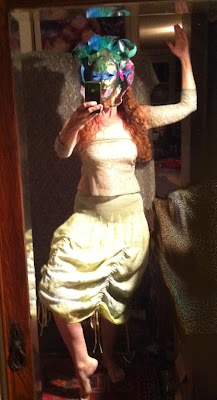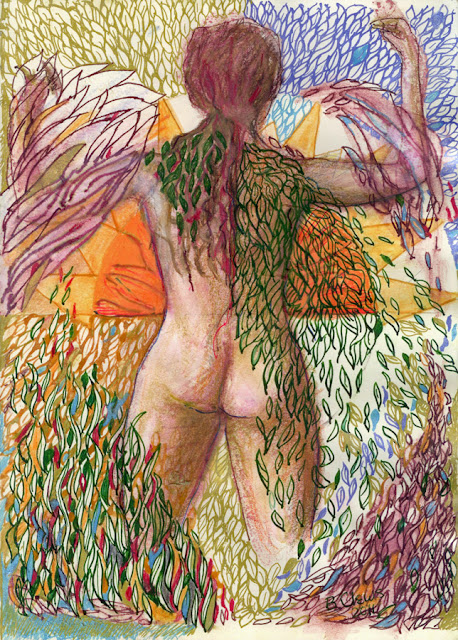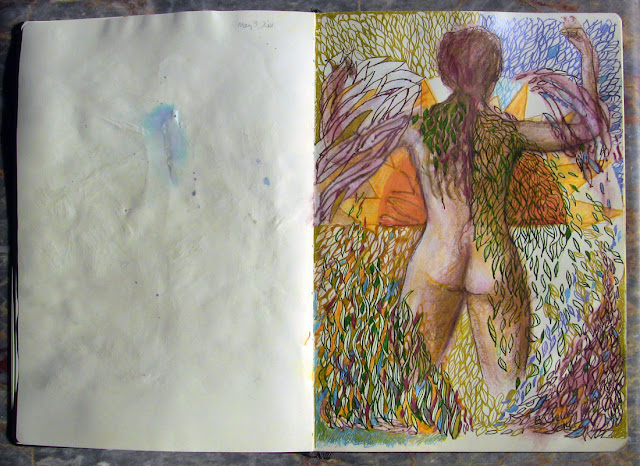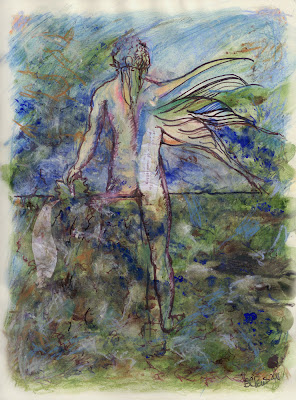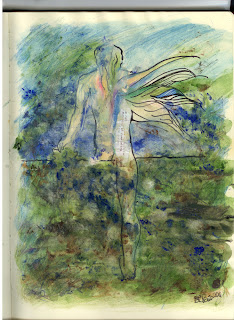direct YouTube link: "Green Goddess" Masque
"Chthonic goddess of the greening earth. Wrinkled, like tree bark, painted, an exotic glade. Process, the recycling of Nature, life emerging from death. An organic art. The mask's fronds as if growing out of the forest floor in the Spring. Papier-mache, mulch: paper, or leaves. The face as landscape; the face carrying the landscape with it. Flower colours framing her face; the iridescence of insects, sheen of dragonfly. Feathery wings, plumed serpent, vestiges of living vines. A vision of a Nature spirit, Summer Solstice, a Midsummer Night's Dream. Shaman of the forest. Tutelary guide in the rainforest. Jungle of the imagination. Then the Surreality of the sky-blue mask on the greening gold fields of her face: I offer you a masked mask."
After the papier-mâché green goddess masque was finished, I wrote some of the thoughts I had while making it. That became the prose poem.
Last Spring I had wanted to make a dancing video with the mask and the prose poem, but it didn't happen until a few days ago. The footage is from a 4 min clip of the only usable footage from a shoot in High Park in Toronto with my daughter not actually on camera, but affecting things.
A blog post from 2009 with photos documenting the process of making the masque, along with the writing: http://brendaclews.blogspot.com/2009/11/green-goddess-papier-mache-masque.html
This video is part of my multi-media work, 'Green Fire': http://www.brendaclews.com/green-fire
The background birds and forest track is a mix I made mostly from http://freesound.org/
__
In a class once, where the professor had taken us through a very dense reading of a movie, someone asked, 'Did the director think of all that when they made the movie?' While we would like our work, poems, photographs, artwork, videos, to stand on their own, sometimes we also like to discuss some of the thoughts we had while composing them.
I would ask that you please not consider this personal essay as an explanation of the videopoem, though. The response and thoughts of the viewer can and should differ from my own - the artist is never responsible for the meaning of a work, only the viewer, reader, audience has that privilege.
A good poem, for me, is always a repository of a body of knowledge. A poem is a condensation of part of our history, be that political, social, personal, or intellectual. A poem carries a body of knowledge with it, and this knowledge can be unlocked by the reader/viewer who cares to delve into the background of the poem's images.
All I'm doing here is talking a little of my thought process while making the masque and composing the videopoem. Some of the knowledge I have gathered and woven into this piece. Your responses to the final product, the videopoem, will, of course, be different.
Here are some of my meandering notes:

My masque wears the landscape of the green goddess. I sought to create a figure representing the processes of life, death, recycling/rebirth in the performance - through the costume with its mask, the movement, and the prose poem. I hoped to achieve a videopoem that was ethereal, earthy, surreal and entertaining.
In the process of making the masque, planning a videopoem, sewing a costume, and the 30 hours of editing the footage into the video you see here, many thoughts crossed my mind. I'll briefly touch on a few themes: a resonance with the Green Man motif, Minerva's owl, a little on subjectivities or notions of the self, that this is also a Solstice celebration, and about my discomfort with producing 'creative movement/dance' videos at my age.
My "Green Goddess" masque reminds me of the Green Man: a drawing or sculpture "of a face surrounded by or made from leaves. Branches or vines may sprout from the nose, mouth, nostrils or other parts of the face and these shoots may bear flowers or fruit." The Green Man is usually an architectural ornament on churches, buildings or gates in parks, and so on. The article in Wikipedia continues, "The Green Man motif has many variations. Found in many cultures around the world, the Green Man is often related to natural vegetative deities....Primarily it is interpreted as a symbol of rebirth, or "renaissance," representing the cycle of growth each spring." The 'Green Goddess' masque has leaf-like fronds in her headdress and the colours of the wilds on her painted face. My prose poem refers to many of the same vegetative processes of nature. The dance is meant to be of a nature spirit. She is like a counterpoint to the Green Man. They are fertility figures, emblems of the fecundity of Nature.
I included the sound of an owl hooting; though the video was shot in daytime, I created darker clips in the editing to create a motion of light and dark throughout the video. Always in the jungle there is danger (I lived in an African jungle in Zambia as a child so know this), and the owl carries that haunting in its birdcall. The owl is also sacred to the Ancient Roman goddess, Minerva: "She was the virgin goddess of poetry, medicine, wisdom, commerce, weaving, crafts, magic, and the inventor of music. She is often depicted with her sacred creature, an owl, which symbolizes her ties to wisdom." All of which is appropriate to this videopoem.
Being a 21st century woman, concepts of subjectivities, construction of the self, the ego, in the midst of the natural abundances of the earth, the way as individuals we are part of the larger processes of life and death is important. Hence the masque. Who are we?
During the days it took to make the papier-mâché mask, I thought about how our masks enable us to be who we are. Our performative aspects reveal us to ourselves and others. We construct ourselves through our masques, and reveal ourselves more fully to each other when we are disguised. Yes, I know it is a bit of a double take, and the opposite approach to the Buddhistic peeling of layers of the self to arrive at essence. Yet, like the Buddhist practitioner sits in the semi-lotus pose of the Buddha meditating, and thus takes on the pose (or mask) of the Buddha to achieve selflessness, the masque also removes individual personality and reveals the archetypal nature of our essence.
Masqued or un-masqued, wearing a mask to represent the deity, to represent the spirit being called, or peeling away layers, perhaps we arrive at the same realization of 'selfless self.'

A forest doppelgänger appeared in the footage, in the imprint of a large woman of leaves, a reflection of the dancer, and I have no idea how that happened, and was not able to produce it in other sections, but I really grokked it. That vegetative figure has resonances with resurrection motifs, perhaps even the horror genre of movies when plants take on human form and come to life. A bit humorous, yes. Yet it is as if the masqued shamanic dancing called the spirit forth. A large figure emerges like a forest angel, the manifested double of the woman dancing a medicine dance, a potent force of the power of nature, a little dangerous if not directed properly by the shaman to become the energy of a spirit of healing. The appearance of a doppelgänger has made me very happy with this little video.

It is nearly Solstice, and a celebration of the sun at its zenith in the sky in the Northern Hemisphere here in Canada. I edited the video to culminate in a moment of solar worship, an adoration of the light of life, perhaps the figure becomes a solar priestess for a moment (for she has long since stopped being me), along with the overall representations of the fertility, decay and recycling of greening Nature.
The video is delicately layered and looks best on HD. Different parts of it play in differing speeds of slow motion. The video itself is composed like a compressed poem of images, and is one of my best video poems, I feel. It is, of course, not without humour.
If I'd had this technology 20 years ago! It is hard to produce 'dance videos' at my age, especially in a culture that focuses on youthful beauty, and while there are two more planned (since musicians have sent me music for specific performance pieces), I may not be able to do these types of "creative movement/dance" videos much longer. If I get those last two done, this year will have seen 5 dance videos, wow. A long-time dream, to do this, to create poetry dance videos.
The woman in the "Green Goddess" masque, therefore, wishes you the courage to realize your dreams.
-
Joining July's Festival of the Trees with this video poem on the shaman of the forest.
Little update: I also took this video poem with me last Sunday, along with some photos of the making of the masque, to a Digital Storytelling workshop (I can't find a direct link, but it's at NFB Mediatheque) with my independent film group at NFB (National Film Board), and was surprised at the positive comments from other participants and NFB staff that I received. Unfortunately, the computer I was working on there froze, so I don't have the piece I produced to show you - though I will link to the video slideshows produced by our group when they become available.






